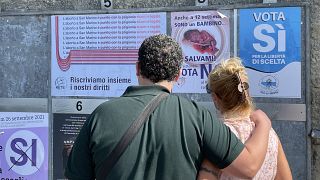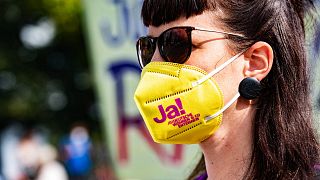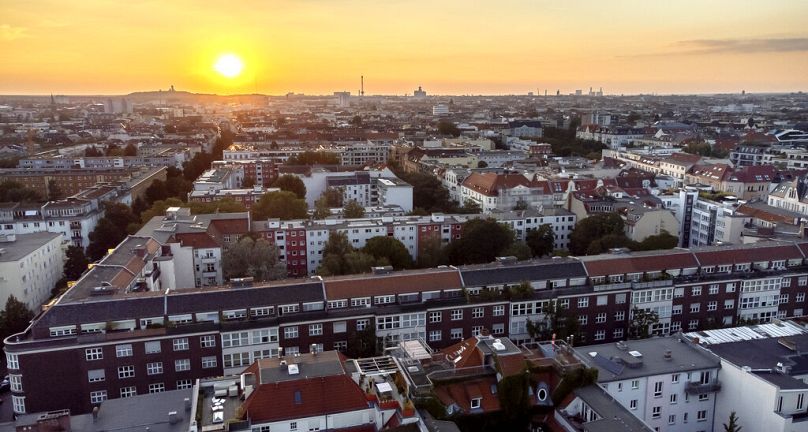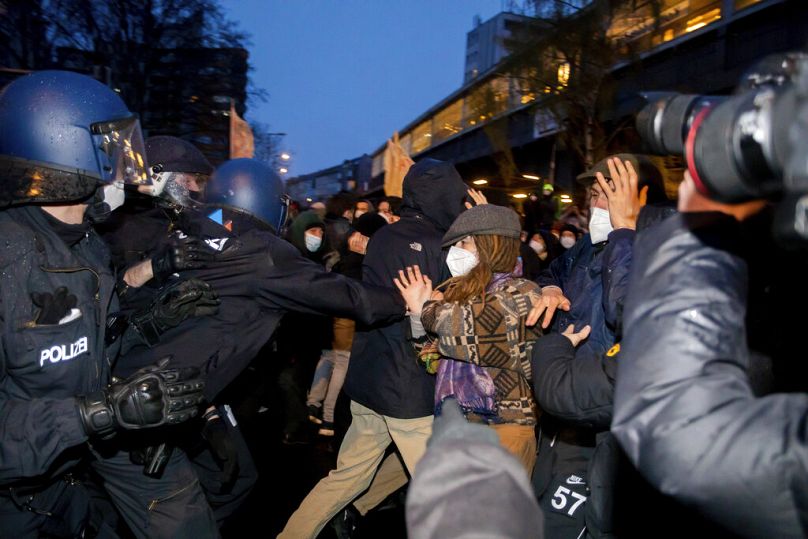By Aleksandar Brezar • Updated: 09/09/2021
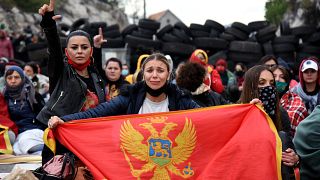
Demonstrators gather at a barricade set up to block access roads to Cetinje during a protest against the inauguration of the new head of the Serbian Orthodox Church - Copyright Credit: AFP
Orthodox priests dressed in their long, black garb, rushing out of a helicopter as their long grey hair and beards are blown all over the place by the propellers.
Riot police quickly unravel a black kevlar blanket to cover them up, while others with automatic rifles poised encircle the perimeter.
No, this is not a scene from Apocalypse Now.
Last weekend Montenegro, better known for its beautiful coast, striking mountain ranges -- and for hosting the odd Russian dissident over the years -- became the epicentre of a new Balkan crisis.
It happened when the Serbian Orthodox Church (SOC) installed a new leader in a ceremony in Montenegro, angering some Montenegrins who saw it as a symbol of influence from its bigger neighbour.
SOC lost both its patriarch, or the head of the church, and the head of its branch in Montenegro, titled as metropolitan, in October and November of last year. Both contracted COVID-19 and died within less than a month.
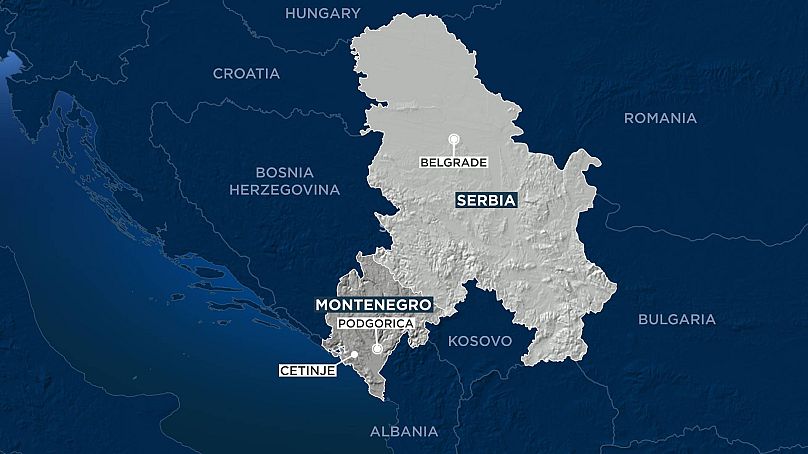
What's the history behind today's row?
Serbia and Montenegro are neighbouring countries that outsiders would consider culturally and historically similar. Yet among southern European Slavic nations, it's the differences that respective ethnic groups cling to the most strongly and that build the basis for their national identities -- especially in the post-socialist era.
Montenegro had a circuitous path towards independence that differs strongly from that of most Balkan or even European nations. It first became an independent principality in 1852, which is also the first time it declared the separation of church and state power.
A parliamentary decree in 1918 saw Montenegro, which was declared a kingdom in 1910, join Serbia and subsequently became a part of the Kingdom of Yugoslavia.
The Montenegrin king at the time, Nikola I Petrović, fled to Marseille in 1916 after the country’s capitulation and occupation by Austro-Hungary and set up a government in exile.
Petrović and the Serbian royal family, the Karađorđevićs, were already bickering over how power should be shared before King Nikola I left the country. With him absent, and with the Serbian army still in the country at the very end of World War I, a Serbian government-appointed committee set up an ad hoc assembly in Podgorica to formalise the Karađorđević rule over Montenegro and its unification with Serbia.
A headline in The New York Times at the time called it “Annihilation of a Nation”. The remaining supporters of King Nikola rejected the union, which they saw as more of annexation and even instigated the Christmas rebellion of 1919, while Nikola petitioned the Paris Peace Conference to reinstate Montenegrin independence. It ended up being rejected.
While ethnic identities had a completely different meaning at that time, one of the reasons why a part of the local population accepted the Karađorđevićs was because they too had Montenegrin heritage. Even back then, there were debates about Montenegrin versus Serbian identity.
The political unification paved the way for the re-founding of the Serbian Orthodox Church in 1920 by the decree of the Yugoslav king, Aleksandar I Karađorđević, with the idea of unifying all Orthodox ecclesiastical provinces and eparchies under one rule.
“With the autochthonous Montenegrin Orthodox Church (MOC) now reduced to a metropolitanate or branch of the SOC, the SOC profited from the union, gaining rights to overall property deemed belonging to the Orthodox Church.
The crucial thing to remember is that this moment in history, when churches and their property in Montenegro became property of Serbia -- and then, property of the Serbian Orthodox Church -- would come to rear its head a century later.
A fight for the soul of the country
Yet because of their similarities -- including the fact that ethnic Montenegrins and ethnic Serbs are nominally Eastern Orthodox believers -- many in Montenegro feel that Serbia has preferred to erase their differences in its favour rather than grant their neighbours the right to determine what they call themselves, their language and their church.
This is why hundreds of Montenegrins gathered in Cetinje on Saturday, setting up barricades with large stones and car tyres, blocking the road with the goal of preventing the new metropolitan from being anointed.
Cetinje, a city founded in the 15th century, is located at the foot of Mount Lovćen and was the seat of the royal family. Home to the first printing press in Southeast Europe and the Cetinje Monastery, it is widely considered the cradle of Montenegrin culture.
On Sunday morning, with no signs of the inauguration being postponed, the protests turned ugly. Police tried to disperse the crowds by repeatedly firing canisters of teargas and flashbang grenades at the protesters gathered in Cetinje’s central promenade.
With the standoff entering its second day and the roads to the city still blocked, the metropolitan was flown in from Podgorica by helicopter. Joanikije and Patriarch Porfirije were hastily escorted into the monastery, and after a brief ceremony, flown back to Podgorica, while Cetinje was still covered in a cloud of teargas.
A total of 60 people were reported as injured — 20 police officers and 40 citizens.
Upon his departure to Belgrade on Sunday, Patriarch Porfirije stated in an Instagram post that he is leaving “this blessed land and people with mixed feelings.”
“I thank everyone and feel sorry for all of those who were hurt in some way and I ask for forgiveness. I pray to the Lord for this country, these people and all people, and I ask them to pray for me because they are closer to God,” he concluded.
Montenegro's coalition government was divided on how to handle the crisis.
While Prime Minister Zdravko Krivokapić called for peace on social media at the height of the protests, his coalition partner party, URA, asked for the ceremony to take place elsewhere.
Vice President of URA, Jovana Marović, told Euronews the church heads rejected this.
"URA made several appeals for the anointing of the Metropolitan to be moved to another location because of the security risks and increased tensions. The Metropolitanate did not want to consider that option, despite the barricades on the road and other risks. The only option left to the government was to guarantee the safety of the citizens in Cetinje and try to let the event take place without significant incidents," she explained.
However, this meant that the government found itself having to take one side, or none at all -- both being difficult choices, according to Marović.
"A segment of the citizens and political parties had expected the government to pick between two guaranteed rights, between the right of assembly and the right to religious freedoms. However, all rights are guaranteed and are equal, so the government tried to provide both."
The protesters were angry that their own government provided a helicopter for the ceremony, while others were upset that PM Krivokapić participated in a celebratory lunch with the SOC immediately after the event in Cetinje. Still, others thought that there should have been harsher reactions to the roadblocks.
"Certain parties in the governing coalition reacted harshly to Sunday's events, so can expect the political sparring to become even more intense," she said. URA has positioned itself as the country’s only true civic movement. It is the junior coalition partner in a government formed by Krivokapić's For the Future of Montenegro, a populist party that pushed out the long-ruling Democratic Party of Socialists, or DPS, in elections held last year.
Krivokapić, a Montenegrin university professor, rose to prominence during a series of protests in reaction to a law on religion began in late 2019. The law intended to effectively reverse the takeover of what was once Montenegrin church property after 1918 and return it to the state. The protests were led by senior members of the Serbian Orthodox Church.
The original law proposed by DPS passed in late December 2019 — dubbed the 'Law on Religious Freedoms' — pledged to return all property granted to the SOC after 1918, unless they had proof of ownership prior to that year.
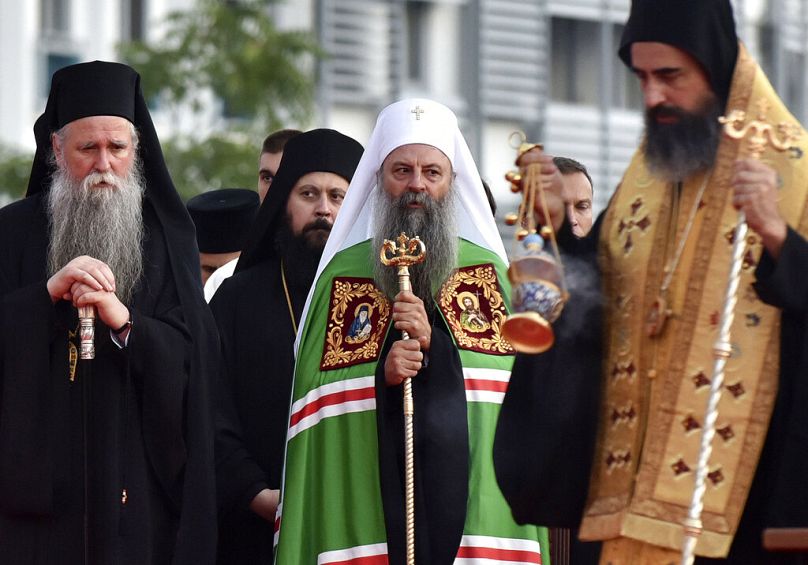
National versus religious identity
The role of the SOC was never simply that of a religious institution, explains Ivan Videnović, associate professor at the University of Belgrade.
"The SOC with its 'one faith, one people' doctrine was an important political actor in all phases of the modern history of the Balkans it had any influence on,” says Videnović.
When the SOC initially took over church properties in the early 20th century and became the main ‘umbrella’ for all Eastern Orthodox Churches in the region, it did so to centralise the Orthodox believers in a region where Catholic and Muslim believers were also common.
Could you be Serb and not Orthodox? Or Orthodox and not Serb? At that time, and especially before the 20th century, yes. But as the church became more powerful and formed stronger ties to the political project of the Serbian nation-state, this became less acceptable.
“This doctrine doesn't recognise the existence of Muslim Serbs or Catholic Serbs, just like it doesn't recognise the existence of Orthodox Montenegrins or Orthodox Macedonians,” Videnović explained.
This is why some Montenegrins feel strongly about having their own autocephalous or recognised independent Church. If one side spent the past century claiming that if you were part of the Serbian Orthodox Church you were a Serb, then there is a need for a Montenegrin Orthodox Church.
"This leaves the majority Montenegrin population in a civic state like Montenegro either without its own church or in a situation to bow down to the church that doesn't recognise their ethnic origin or their language. The denial of Montenegrin identity in the past years was often accompanied by outbursts of hate speech by the SOC dignitaries toward the Montenegrin ethnic group or the government of Montenegro," he said.
Montenegro: the last Yugoslav crisis
Montenegro only became a distinct territory again after World War II as one of the six republics of the Socialist Federative Republic of Yugoslavia.
As adherence to the communist ideology of secularism weakened and nationalist tendencies became more prominent, the SOC regained its prominence as a key political factor.
Slobodan Milošević, a communist apparatchik that later became the main proponent of Serbian nationalism, realised that he needed the church as a tool to rally ethnic Serbs around his political mission. Milošević's incitement of ultranationalist Serbian sentiments as early as the mid-1980s is widely regarded as one of the primary triggers of the bloody dissolution of Yugoslavia and the ensuing wars.
After the breakup of Yugoslavia in the early 1990s, Montenegro was the only one of the six to remain in the union with Serbia. At a moment when the fault lines of the conflict were between those considered Catholic, Muslim, Orthodox or Albanian, the two main Orthodox nations in Yugoslavia -- the Serbs and the Montenegrins -- didn’t openly clash or engage in warfare. In fact, Montenegro participated in the wars together with Serbia. The current president of Montenegro, Milo Đukanović, was one of Milošević’s closest allies -- at least at first.
Đukanović has been a key political actor in Montenegro since the late 1980s when he rose to prominence with Milošević’s support. Starting in 1991, he served as the country's PM four times and is in his second mandate as president. Although initially, he was loyal to Milošević's cause, having his government send troops to Croatia and playing a role in the war in Bosnia, Đukanović did a U-turn in the mid-1990s, openly criticising Milošević and his regime and eventually distancing himself and the country from Serbia altogether.
The bread and butter of Đukanović's political rhetoric and the main reason behind his unusual political longevity — as marred as it has been with constant accusations of significant corruption and participation in organised crime — was tying his change of heart to him becoming the main advocate Montenegrin identity as distinct and separate concept.
His party's proposal to take away the SOC's property was a step too far, however, and Đukanović underestimated the power the SOC wielded in Montenegro. This was actively exploited by the Serbian government, which according to Videnović, has instrumentalised the SOC to regain some of its lost influence since 2006.
"The government in Belgrade is the main factor responsible for the current situation, for playing the endangered collective interest of Serbs in a country where true human rights were never denied to anyone, for involving the SOC in the [2020] electoral race, and for influencing the appointment of the current government of Montenegro," Videnović claims.
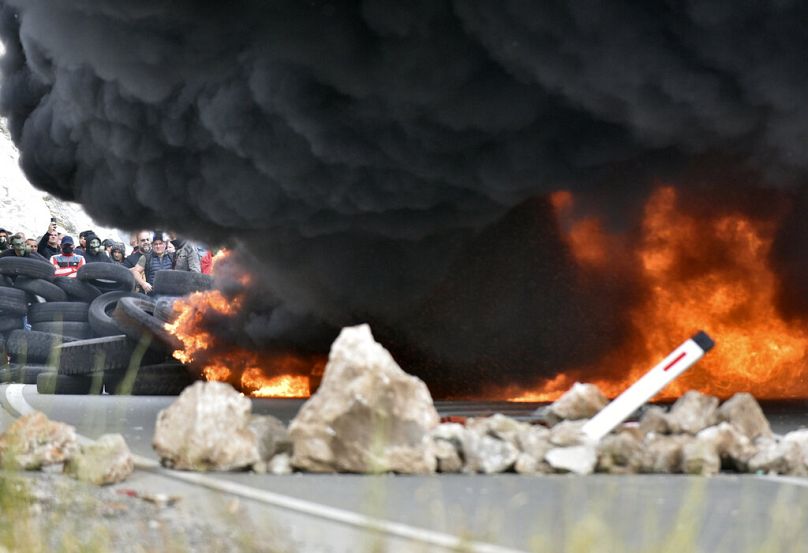
"This is why ethnic Montenegrins perceive the current government as Belgrade's puppet, while the entire process of clericalisation of the country is further seen as an attempt to take away their national identity, state independence and interethnic accord."
But the previous rule of the country's current president Milo Đukanović and his DPS is also to blame.
"Đukanović's responsibility lies in the fact that he failed to include the more Europe-oriented Montenegrin Serbs into his program of a civic, multinational society. They felt rejected by his overemphasis on the particularity of Montenegrin identity all the way to the return to the archaic divisions from the past," Videnović concludes.
Đukanović's opponents saw this as an opportunity to gather support and, finally, dethrone him. The SOC's help proved to be vital, says Ljubomir Filipović, activist and executive coordinator of the 21st May Civic Initiative. The movement was one of the participants in last weekend’s protests in Cetinje.
"The SOC used the discontent over the church property law to launch a campaign of clerical protests and rallies which coincided with the pre-electoral campaign in the country," he said, "and the political subjects close to these protests won the elections in the country."
A new leadership does not necessarily mean a better one, Filipović believes.
"A corrupt government with a multitude of problems was replaced by another government that engaged in historical revisionism and supported ideologies that were responsible for the nationalist euphoria that led to the conflicts in the 1990s," Filipović explains.
"A minister in the current government was recently removed from his position for denying the Srebrenica genocide. They want to maintain the appearance of having pro-Western leanings because they know that not doing so would endanger their power."
"They now insist on blaming all the problems in the country on the Democratic Party of Socialists, who lost power and key positions in the country, so they want the protests in Cetinje to be seen as a result of DPS's anger over losing power – which is not true," he said.
According to Filipović, the protest movement is, in fact, very diverse.
"Reducing it to what people are calling Montenegrin nationalism is just as unfair as reducing the entire Euromaidan in Ukraine movement to fascists. There is a wide spectrum that's included, from the left to the right, but our goal is to subvert the clerical and Serbian political influences on Montenegrin politics," Filipović explains.
The protests against the inauguration in Cetinje rejected the symbolic act of the subjugation of Montenegro to take place in Cetinje, and many are extraordinarily angry, Filipović said.
The MOC, whose ecclesiastical independence or autocephaly was never formally recognised, had a revival in the early 1990s, and became a recognised religious community by the country's government in 1999.
A 2020 poll by a Montenegrin NGO CEDEM showed that about 10 per cent of Montenegro's Orthodox Christian faithful see it as their church. It has its metropolitan, Mihailo, also seated in Cetinje.
But the MOC has little if any political influence on what goes on in Montenegro -- a stark contrast to the SOC's leaders, who are very present in public and often outspoken in their ultraconservative views.
Joanikije's predecessor, Amfilohije, famously supported the wartime Bosnian Serb leader Radovan Karadžić, admitting in 2010 that he offered him a place to hide after the ICTY indicted Karadžić for war crimes in Bosnia right after the 1992-1995 war.
'Everyone looks bad after Sunday'
Sunday’s inauguration of the new metropolitan has now tarnished Joanikije's legacy from the very start of his headship, according to Daliborka Uljarević, executive director of the Center for Civic Education, a Montenegrin civil society nonprofit.
"Instead of it being a dignified event, they had to be smuggled into the monastery encircled by police with automatic rifles. How can someone who is a true Christian live with the weight of such an anointment?"
"The SOC is not a winner here," Uljarević said. "The church has to have a conciliatory influence on society, and not the opposite. To try and find solutions that are outside the expected framework and not to ignite tensions."
"I think Metropolitan Joanikije's statement that he will work on dialogue and reconciliation is hypocritical, considering that he lost the legitimacy to discuss these topics by forcing this event," she stated.
"He could have won so much support and legitimacy if he himself had decided to pull out of the ceremony and said I see that this is antagonising the society."
For Montenegrin citizens of all ethnicities, another layer of frustration comes from the fact that the situation's complexity is unfamiliar and confusing to many outside of the country, making it hard to comprehend even to Montenegro's closest neighbours.
"Montenegro didn't attract much attention for many years – it wasn't a regional problem," Uljarević stated.
"These past years, questions that were previously an extremely internal issue and that were complex for Montenegrin society to deal with have now been spilt outside of our borders."
When it comes to finding the right solution and reuniting the country and its citizens, this is not an issue that can be settled overnight according to Uljarević -- despite PM Krivokapić's congratulatory tone at a press conference on Monday, where he said that the country is now free to move on to resolving other issues, such as its economic woes.
"I'd define what's happening in Montenegro as a political issue that has been fused with a religious and identity issue, which then brings various emotions to the fore and mobilises people," she said.
"Montenegrin society now needs to go back and address issues that were kept on the backburner and to try and reach an agreement on what sort of country we want."
